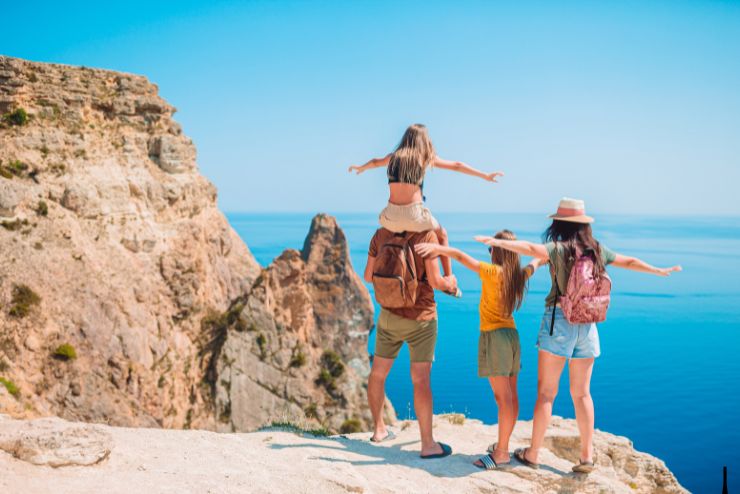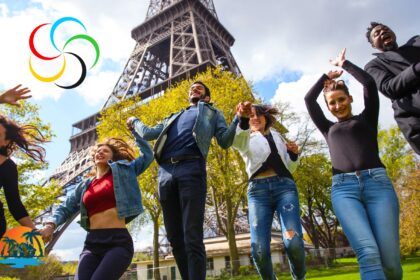You’ve just returned from an incredible vacation. Your phone is filled with sunset photos, your mind holds precious memories of new experiences, and for a brief moment, you feel completely recharged. Then Monday morning hits like a freight train. The alarm sounds harsher than usual, your regular coffee tastes bland compared to that perfect café au lait you had in Paris, and suddenly, you’re googling “how to move to Bali permanently” from your office desk.
Welcome to the post-vacation slump – that soul-crushing phenomenon that makes returning to regular life feel like stepping from Technicolor back into black and white. If you’ve ever felt more exhausted after a vacation than before it, experienced intense sadness when your trip ended, or found yourself counting down days until your next escape before you’ve even unpacked, you’re not alone.
The post-vacation blues affect up to 57% of travelers, according to recent studies, and the symptoms can last anywhere from a few days to several weeks. But here’s the good news: this emotional rollercoaster is completely normal, scientifically explainable, and most importantly, manageable with the right strategies.
READ ALSO: How to Dress Stylish While Traveling
Understanding the Science Behind Post-Vacation Depression
The Neurochemical Comedown
Vacations trigger a powerful cocktail of feel-good chemicals in our brains. When we’re exploring new places, trying different foods, and breaking free from routine, our brains release increased levels of dopamine (the reward chemical), serotonin (the happiness chemical), and endorphins (natural painkillers that create euphoria).
During vacation, we’re essentially in a heightened state of neurochemical bliss. Our stress hormone cortisol decreases while pleasure-inducing chemicals surge. When we return to familiar environments and routines, this chemical production drops dramatically, creating what researchers call “hedonic adaptation” – our brains quickly return to baseline happiness levels, making regular life feel comparatively dull.
The Anticipation vs. Reality Gap
Psychologists have identified that much of our vacation happiness actually comes from the anticipation leading up to the trip. The planning phase, imagining experiences, and looking forward to the break can boost mood for weeks or even months before departure. When the vacation ends, we lose both the actual positive experiences and the anticipatory excitement, creating a double emotional deficit.
Routine Shock
Vacations temporarily liberate us from the mundane aspects of daily life – commutes, meetings, household chores, and rigid schedules. The sudden return to these responsibilities can feel jarring and oppressive, especially when contrasted with the freedom and novelty we just experienced. This “routine shock” is compounded by the fact that we often return to the same stressors and challenges we left behind, but now they feel magnified after our temporary escape.
Recognizing Post-Vacation Slump Symptoms
Understanding that your post-vacation feelings are legitimate and common is the first step toward managing them effectively. Common symptoms include:
Emotional Symptoms: Sadness, irritability, anxiety, feeling overwhelmed, loss of motivation, and a sense that life lacks excitement or meaning.
Physical Symptoms: Fatigue despite adequate sleep, changes in appetite, difficulty concentrating, and feeling physically sluggish.
Behavioral Symptoms: Procrastination, withdrawal from social activities, excessive social media scrolling (often looking at vacation photos), and immediate planning of the next escape.
Cognitive Symptoms: Negative comparison between vacation experiences and daily life, romanticizing the vacation while catastrophizing current circumstances, and difficulty focusing on present tasks.
The Strategic Approach to Beating Post-Vacation Blues
1. Master the Art of Gradual Re-entry
One of the biggest mistakes travelers make is scheduling their return flight to land Sunday night with work starting Monday morning. This abrupt transition amplifies post-vacation depression by forcing an immediate shift from relaxation to high-stress productivity.
Buffer Day Strategy: Always build in at least one full day between your return and resuming work obligations. Use this day for gentle re-entry activities like unpacking mindfully, grocery shopping, light cleaning, and adjusting to your time zone. This buffer day serves as a psychological bridge between vacation mindset and work mode.
Gradual Schedule Ramping: If possible, ease back into your full schedule over several days. Start with lighter commitments and gradually increase intensity. Many successful business leaders deliberately schedule fewer meetings and less demanding tasks for their first week back.
Sleep Schedule Adjustment: Begin adjusting your sleep schedule 2-3 days before returning home, especially if you’ve crossed time zones. Gradual adjustment prevents jet lag from compounding your emotional transition difficulties.
2. Extend Vacation Elements into Daily Life
Rather than viewing vacation as a complete departure from regular life, identify specific elements that brought you joy and find ways to incorporate them into your routine.
Sensory Integration: If you loved the smell of ocean air, invest in a sea salt diffuser. If morning coffee at a sidewalk café was magical, create a similar ritual at home or find a local café that captures that atmosphere. Our senses are powerful triggers for positive memories and emotions.
Activity Adoption: Did you love daily walks through new neighborhoods? Start exploring different areas of your own city on foot. Enjoyed trying new cuisines? Make it a weekly goal to cook dishes inspired by your travels or visit restaurants serving food from places you’ve been.
Mindset Importation: Vacations often involve a more present-focused, curious mindset. Practice bringing “tourist eyes” to your regular environment by noticing details you usually overlook, trying new routes to familiar places, or approaching routine activities with fresh curiosity.
3. Create Positive Return Rituals
Develop meaningful rituals that help you process and integrate your vacation experiences while creating something to look forward to about being home.
Memory Processing Sessions: Set aside dedicated time to go through photos, write in a travel journal, or create a photo book. This helps your brain properly file and integrate the experiences rather than leaving them as floating fragments that create longing.
Gratitude Practice: Spend 10 minutes each morning for the first week back writing down three things you’re grateful for about your trip and three things you appreciate about being home. This practice helps balance perspective and prevents all-or-nothing thinking about vacation versus daily life.
Welcome Home Treats: Plan specific comforts that you can only enjoy at home – maybe it’s your favorite local restaurant, a particular bath product, or sleeping in your own bed with familiar pillows. Having home-specific pleasures to anticipate makes return feel like a positive choice rather than a disappointing obligation.
4. Address the Underlying Issues Vacation Revealed
Often, the intensity of post-vacation depression correlates with how much we were using the trip to escape underlying dissatisfaction with our regular lives. While vacation blues are normal, severe or prolonged symptoms might indicate deeper issues worth addressing.
Work Satisfaction Assessment: If returning to work feels particularly unbearable, this might be signaling legitimate concerns about job satisfaction, work-life balance, or career direction. Use this awareness as motivation for positive changes rather than just enduring until the next escape.
Relationship Evaluation: Notice how you feel about returning to your social circle and family dynamics. Vacation sometimes provides clarity about relationships that drain versus energize us.
Lifestyle Audit: Consider whether your regular routine truly reflects your values and priorities. Post-vacation depression can be a wake-up call to make meaningful life changes rather than just planning more frequent escapes.
5. Harness the Power of Active Recovery
Instead of passively waiting for post-vacation blues to fade, engage in active recovery strategies that help your brain and body readjust while maintaining some of the positive neurochemical benefits of travel.
Exercise Integration: Physical activity naturally boosts mood-regulating chemicals. If you were more active during vacation, maintain that momentum with regular walks, bike rides, or trying new fitness classes. The key is finding movement that feels enjoyable rather than punishing.
Social Connection: Vacation often involves quality time with loved ones or meeting new people. Combat post-vacation loneliness by scheduling meaningful social activities for your first week back. Share your experiences with friends, but also engage in present-focused activities together.
Creative Expression: Many people feel more creative and inspired during vacation. Channel this energy into creative projects, whether it’s cooking new recipes, writing, photography, or learning skills related to your travel experiences.
6. Build Anticipation Without Escapism
One of the most effective ways to combat post-vacation blues is having something positive to anticipate. However, it’s important to distinguish between healthy anticipation and escapist thinking.
Short-term Planning: Schedule enjoyable local activities for the weeks following your return. This might include concerts, museum visits, weekend day trips, or dinner reservations at restaurants you’ve wanted to try. Having these events on your calendar provides positive anticipation without requiring major time or financial investment.
Learning Pursuits: Use inspiration from your travels to start new learning projects. Take a cooking class featuring cuisine from your destination, learn phrases in a language you encountered, or study the history and culture of places you visited. This creates ongoing connection to your travel experiences while enriching your daily life.
Future Travel Planning: While it’s healthy to plan future adventures, avoid using next vacation as the sole source of motivation for enduring present circumstances. Balance future travel planning with investments in making your current life more fulfilling.
Long-term Strategies for Vacation Integration
Develop a Travel Philosophy
Rather than viewing vacations as temporary escapes from “real life,” develop a philosophy that integrates travel experiences into your overall life narrative. Consider questions like: What do my travel choices reveal about my values? How can I honor the parts of myself that emerge during travel in my daily life? What would it look like to live more like the person I am when I’m traveling?
Create Micro-Adventures
Combat the all-or-nothing thinking that only major vacations can provide joy and novelty. Develop a practice of micro-adventures – small explorations and new experiences that fit into regular life. This might involve exploring different neighborhoods in your city, trying new hiking trails, attending cultural events, or having “staycation” days where you treat your hometown like a tourist destination.
Build Resilience Through Routine Enhancement
Instead of viewing routine as the enemy of excitement, focus on creating routines that genuinely serve your well-being. This might involve morning rituals that set a positive tone for your day, evening practices that help you unwind, or weekly activities that provide consistent sources of joy and connection.
When to Seek Additional Support
While post-vacation blues are normal, sometimes the symptoms indicate or trigger more serious mental health concerns. Consider seeking professional support if you experience:
- Depression that lasts more than two weeks after returning
- Anxiety that interferes with work or relationship functioning
- Persistent thoughts that life isn’t worth living without constant travel
- Using vacation planning or travel-related spending as a primary coping mechanism for life stress
- Inability to find any joy or satisfaction in daily life activities
Mental health professionals can help distinguish between normal adjustment difficulties and more serious conditions while providing targeted strategies for your specific situation.
Creating Your Personal Post-Vacation Recovery Plan
The most effective approach to managing post-vacation blues is developing a personalized plan that accounts for your specific triggers, preferences, and circumstances. Consider creating a “recovery toolkit” that includes:
Immediate Strategies: Activities and mindsets you can employ in the first 48 hours after returning to ease the transition.
First Week Protocols: Specific plans for gradually resuming full responsibilities while maintaining self-care practices.
Integration Activities: Ways to process and incorporate vacation experiences into your ongoing life story.
Future Planning: Balanced approach to anticipating future travels while investing in present life satisfaction.
Support Systems: People and resources you can turn to when post-vacation feelings become overwhelming.
Embracing the Full Travel Experience
Ultimately, learning to navigate post-vacation blues is about embracing the full spectrum of the travel experience. The temporary sadness of ending a wonderful trip is actually evidence that you’re capable of deep joy and that travel serves an important function in your life. Rather than trying to eliminate these feelings, we can learn to experience them as a natural part of meaningful adventures.
The goal isn’t to never feel sad about vacations ending, but to develop skills for processing these emotions in healthy ways while building a daily life that feels worth returning to. When we master the art of vacation integration, we can enjoy both the peak experiences of travel and the satisfying rhythms of home life, creating a rich and balanced approach to happiness that doesn’t depend on constant escape.
Your post-vacation blues are not a character flaw or a sign that you’re ungrateful for your regular life. They’re a natural response to transitioning between different modes of being, and with the right strategies, they can even become a catalyst for creating more joy, meaning, and adventure in all aspects of your life. The key is learning to surf these emotional waves rather than being crushed by them, using each return as an opportunity to integrate the best parts of your travel self into your everyday existence.
In another related article, The One Thing I Always Do Before Vacation That Makes Coming Home So Much Easier







